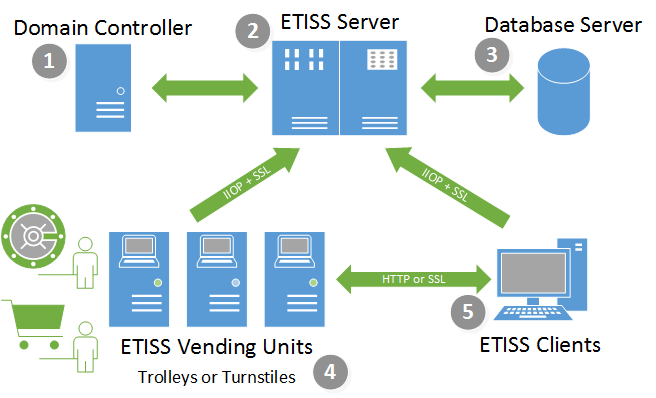The software framework (“ETISS-NG”) supports the business process for the luggage trolley deposit system. For the luggage trolley deposit system, so‐called trolley stations are set up, which have one or more row(s) of trolleys. A user receives a trolley after paying the deposit. If there are several rows, a traffic light system indicates the row in which a trolley can be extracted. Conversely, a coin is returned to the user after inserting a trolley in the rail or in the latch box. A station consists of a teller machine connected electrically to one or more rail(s). By way of a socalled latch box at the start of the rail, trolleys are inserted into the rail by means of adapters, are registered and are held along the rail. The latch box releases a trolley as soon as a deposit has been paid on the teller machine.
The data gathered by the trolley machine is stored centrally in a database and is displayed and managed by means of the “ETISS-NG” software described here. All relevant data are stored in a central database. The client application (program for display, management and monitoring of system operations) uses this database for administration and management of the machines. The communication between the individual modules of the overall application is mapped via the CORBA (Common Object Request Broker Architecture) industry standard. Logical assignment, processing and distribution of data are mapped via an application server.
Users have to log in or authenticate themselves to be able to start the application. To this end, the access data for a user from the Active Directory is used, i.e. if a user is known to the “ETISS” system and is assigned a role, that user can log in with their known credentials. All data (process data generated by the system or manually entered data) is managed centrally in a database. Additionally, further statistics can be made available for further use in an external application.
The states of the machines are managed via a set of rules managed in the communication service. To this end, the machines’ states are evaluated and are assigned to the properties stored in the set of rules. A monitoring service is integrated in the communication service that detects when a machine has no longer been sending any messages for some time. This causes the communication service to then check the connection to the machine (to point out any problems).
In the “ETISS” program, the business processes are mapped to the client computers of the individual specialist areas. An overview of all existing machines is displayed here. For each displayed machine, a detailed view can be opened in which, among other things, information about current quantities (trolleys and cash) can be displayed. To keep the amount of data in the overall system at a constant level due to the high data volume, data is exported at regular intervals. This data is converted to a CSV format (Character Separated Values) so that can continue to be available for evaluation.




